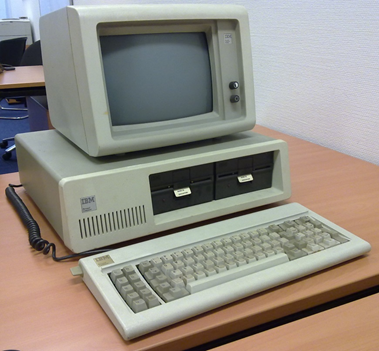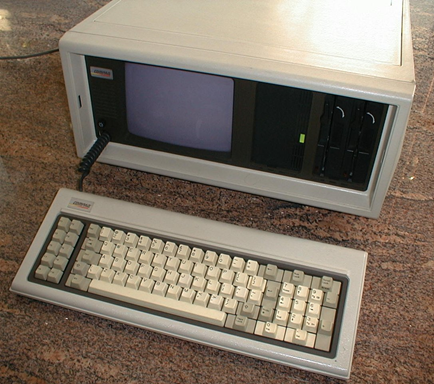Genius versus bricks-and-mortar in the head
Australia could have been the world leader in laptop computers -- if we didn’t have a brain-dead financial sector.
Hannah Francis’ article last week about the Vixtel Unity -- a new Australian-designed multi-function Tablet/Laptop/Phone (The three-in-one Aussie device that could kill the PC) -- seriously stopped me in my tracks when I saw that its developer was Terry Crews. For that reason alone, I popped over to the Indiegogo site where Vixtel is running a crowd-funding campaign and chipped in $645 towards its $100,000 goal -- for which I’ll receive one of the first production run tablets that will be available in July (about 4 to 6 weeks from now).
Why did I do that? Because Terry was the brains behind easily the most innovative computer product ever to come out of Australia: the Dulmont Magnum (see Figure 1). This was a genuine laptop computer, the very first in the world, whose design pre-dated the IBM PC. Any new product Terry Crews is involved in is bound to leap well ahead of the competition, because that was his track record with the Dulmont Magnum itself. This product was so far ahead of the global competition that comparisons are simply laughable.
Figure 1: The Dulmont Magnum -- my own which I purchased back in 1984

When IBM was taking the world by storm with a heavy 3-piece desktop machine powered by a hybrid 8-16 bit processor (it took in data in 256-bit chunks, and then processed it in up to 64K of RAM) running at 4.77MhZ (Megahertz, versus the Gigahertz standard today), 16K (yes, kilobytes) of RAM, and a cassette tape for storage (see Figure 2), a tiny Australian company in Gosford had almost completed the design of a genuine laptop computer with a chip that was two generations more advanced and much faster (the Intel 80186, a true 16-bit processor running at 6 MHz), 64K of RAM and up to 256K of solid state storage (see Figure 1).
Figure 2: The original IBM PC (with optional floppy disc storage)

At the same time as the Magnum was first available in 1983, Compaq launched its portable (see Figure 3), a luggable weighing well over 10 kilos and using the same first generation chip as in the IBM PC. Compaq went on to become the world’s biggest manufacturer of computers before it was taken over by Hewlett-Packard in 2002.
Figure 3: The first Compaq portable--launched in the same year that the Magnum was launched

So what happened to this brilliant Australian product? It failed -- and not because of its hardware, which simply blitzed the field, but because it couldn’t raise the development funding needed to complete its development.
Terry and his team approached virtually every Australian bank at the time, and got the same response from all: “You don’t have bricks and mortar”, as he put it to me last week. The banks looked at this product and simply refused to believe that something like this could be produced in Australia -- despite the fact that they were looking at a fully-functioning prototype. But if you’d like a 95% LVR mortgage, step right this way…
Dulmont did secure interest from an overseas company -- one owned by the Belgian power authority -- but since some Australian government funding had gone into the Magnum’s development, the Belgian company wasn’t allowed to take the more than 49% stake it required.
So Dulmont was forced to try to raise funds by releasing the product before the final bugs were ironed out -- and of course it therefore occasionally crashed on its neophyte buyers. By the time the bugs were ironed out -- by which time I had bought two of them myself -- it worked perfectly, but the company had been taken over by another who thought of the brilliant marketing campaign of having a bikini-clad model holding it in one hand above her head.
Yeah, right, sex sells. But this was something that should have been targeted at “The Big Bang Theory” nerd who could truly appreciate it, and at large corporates who could make their staff mobile before the concept of a mobile office had even been invented. The Magnum -- rebranded as the “Kookaburra” (no comment) ultimately developed a niche market with telecommunications companies needing portable computing power when nothing like it existed, but ultimately the product died.
What would have happened had the Magnum been developed in Gosford, USA, rather than Gosford, NSW? Then it would have been what Compaq became: the world’s leading producer of computers.
Instead, this brilliant product died because Australian banks were too bricks-and-mortar in the head brain-dead to recognise genius when they saw it. And of course they’ve gotten worse since then, with news coming last week that 95 per cent of loans since mid-2012 have gone to property, and only 2.6 per cent went to non-property businesses.
Fortunately, this time Terry Crews’ innovative spirit won’t founder on the shoals of Australia’s property-obsessed banks. The Unity is well funded, and ready for a production run of 5,000 a day as of next month.
So what is special about Unity? Obviously this is an entry into a well-established market, unlike the Magnum itself: there are myriad Tablets out there already. One thing the Unity does is successfully run two operating systems on the one device -- Android for when you use it as a tablet and want to run Android apps, and a tailor-made Linux installation when you want desktop grunt.
Some might think that Microsoft has already done this -- isn’t the Surface Pro a laptop and a tablet in one, as a Twitter follower commented to me (see Figure 4)?
Figure 4: A twitter correspondent getting it wrong

Ignoring for the moment the fact that the latest Surface Pro will cost 3 times as much as the Unity when it is released in August, the answer is no, it doesn’t. Microsoft never managed to get a tablet and a desktop operating system working on the ARM chip in the original Surface, and the new machine is a Windows 8.1 beast only.
The Unity also includes an enterprise-grade PABX system and a Bluetooth phone handset for mobile and VOIP calls. So it fulfils three functions: tablet, PC and phone.
I’m looking forward to receiving mine sometime in July, and I’ll review it here once I’ve put it through its paces. In the meantime, if you’d like to do what Australian banks don’t, and support innovation in Australia, I suggest you pop over to Indiegogo and throw some crowd-funding capital at the Vixtel Unity.
Steve Keen is author of Debunking Economics and the blog Debtwatch and developer of the Minsky software program.
















